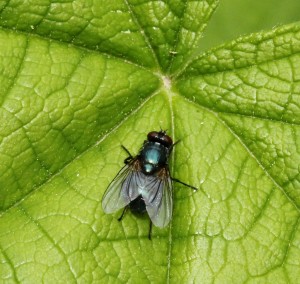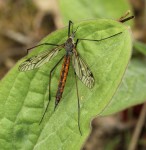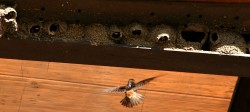Not a single fly buzzes through the house all winter and on a sunny spring day they all seem to come out of the woodwork–quite literally. Flies buzz and bounce off the inside of the windows trying to escape.
No, you don’t have maggots in your garbage that hatched into flies. The flies are probably cluster flies, blow flies or face flies. And they have been there since last fall.
In the fall when the photoperiod (day length) becomes shorter and the temperatures cooler, the “clustering” flies gather on sun-warmed south and west sides of buildings. As night time falls, they crawl into any crack or crevice they can find. Then one day they don’t come out at all.
The flies will enter a suspended state, called diapause, similar to bears and marmots hibernating for the winter. Their metabolic activity decreases and they don’t reproduce or eat.
When the temperature increases and the photoperiod becomes longer they emerge from their resting place–often to the inside.
Distinguishing between the types of flies in your house requires a close look.
Cluster flies are black, three-eighths to a half-inch long with short, yellow hairs on the thorax (middle region). Their wings also overlap when at rest. They are named for their tendency to cluster together in houses.
Blow flies are a metallic green, gray, blue or black color and are strong fliers.
Face flies resemble house flies, which are gray with four dark, longitudinal stripes on top of the thorax. Face flies typically invade a house in the summer.
All flies follow the same life cycle of eggs to maggots to pupa to adult fly. But each fly has a preferred medium for each stage.
Blow flies tend to lay eggs in manure, pet waste or fresh carrion. The sudden presence of blow flies in your house may indicate a dead animal within the home, such as a mouse or squirrel. However, blow flies will seek shelter in homes for winter but the numbers are probably fewer.
House fly larvae feed on garbage, animal waste, compost or spilled animal feed. Adult females can lay 100 to 150 eggs at a time.
The larvae of face flies develops in fresh cattle dung and are more common around farms and ranches.
Cluster flies are not a “filth” fly. They don’t develop in garbage or dung, but instead are parasites of earthworms. A female adult fly will lay eggs in cracks in the soil. When the maggots emerge they will seek out and enter earthworms as parasites. Then they pupate in the soil after leaving the earthworm. They emerge from the soil as an adult fly and know which way is up because they are attracted to light.
The attraction to light perpetuates for adults since they are attracted to lamps and bright windows in houses throughout the winter and spring. The cluster of flies in your windows and light fixtures will die if they don’t escape outside to find food or water.
At least they aren’t there because you forgot to take out the garbage.




